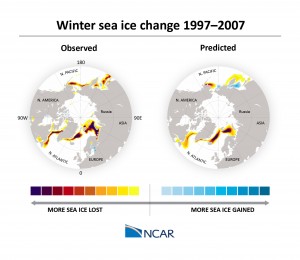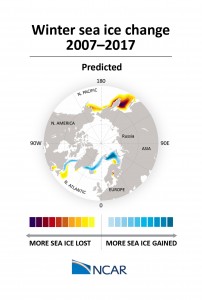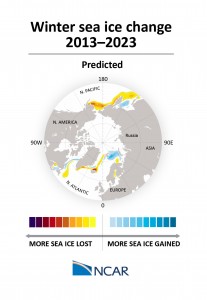8 December 2015
WASHINGTON, D.C. — Climate scientists present evidence in a new study that they can predict whether the Arctic sea ice that forms in the winter will grow, shrink or hold its own over the next several years.
The new study, published today in Geophysical Research Letters, a journal of the American Geophysical Union, finds that changes in North Atlantic Ocean circulation could allow overall winter sea ice extent to remain steady in the near future, with continued loss in some regions balanced by possible growth in others, including in the Barents Sea.

The researchers tested how well they were able to predict winter sea ice changes by “hindcasting” past decades and then comparing their retrospective predictions to observations of what really happened. This image shows how the model stacked up to real life for the period of 1997–2007.
Credit: ©UCAR This image is freely available for media & nonprofit use.
“We know that over the long term, winter sea ice will continue to retreat,” said Stephen Yeager, a scientist at the National Center for Atmospheric Research (NCAR), Boulder, Colorado, lead author of the new study. “But we are predicting that the rate will taper off for several years in the future before resuming. We are not implying some kind of recovery from the effects of human-caused global warming; it’s really just a slowdown in winter sea ice loss.”
Yeager is among a growing number of scientists trying to predict how the climate may change over a few years to a few decades, instead of the more typical span of many decades or even centuries. This type of “decadal prediction” provides information over a timeframe that is useful for policy makers, regional stakeholders, and others.
Decadal prediction relies on the idea that some natural variations in the climate system, such as changes in the strength of ocean currents, unfold predictably over several years. At times, their impacts can overwhelm the general warming trend caused by greenhouse gases released into the atmosphere by humans.
Yeager’s past work in this area has focused on decadal prediction of sea surface temperatures. A number of recent studies linking changes in the North Atlantic Ocean circulation to sea ice extent led Yeager to think that it would also be possible to make decadal predictions for Arctic winter sea ice cover using the NCAR-based Community Earth System Model.

For the decade of 2007-2017, the research team predicts that there may be some growth of winter sea ice in the Arctic Ocean, particularly on the Atlantic side, where scientists have the most confidence in the model’s ability. The image also shows possible sea ice loss in the North Pacific.
Credit: ©UCAR This image is freely available for media & nonprofit use.
Linking ocean circulation and sea ice
The Atlantic Meridional Overturning Circulation (AMOC) sweeps warm surface waters from the tropics toward the North Atlantic, where they cool and then sink before making a return south in deep ocean currents.
AMOC can vary in intensity. When the current is strong, it carries more warm water toward the North Atlantic and Arctic oceans, accelerating sea ice loss. When the current is weak, warm water largely stays further south, and its effects on sea ice are reversed. The variations in AMOC’s vigor—from weak to strong or vice versa—occur over multiple years to decades, giving scientists some ability to predict in advance how it will affect winter sea ice in particular.
Recent research has shown that AMOC now appears to be weakening. Yeager and his co-authors, NCAR scientists Alicia Karspeck and Gokhan Danabasoglu, found in the new study that this change in the ocean circulation is likely to be enough to temporarily mask the impacts of human-caused climate change and stall the associated downward trend in winter sea ice extent in the Arctic, especially on the Atlantic side, where AMOC has the most influence.

For the decade of 2013-2023, the scientists expect to see some winter sea ice loss balanced with sea ice gain on the Atlantic side of the Arctic Ocean, where scientists have the most confidence in the model’s ability.
Credit: ©UCAR This image is freely available for media & nonprofit use.
The limits of a short satellite record
The amount of sea ice covering the Arctic typically grows to its maximum in late February after the long, dark winter. The sea ice minimum typically occurs at the end of the summer season in late September. The new study addresses only winter sea ice, which is less vulnerable than summer ice to variations in weather activity that cannot be predicted years in advance, such as storms capable of breaking up the ice crust.
Despite their success incorporating AMOC conditions into winter sea ice “hindcasts,” the scientists are cautious about their predictions of future conditions. Because satellite images of sea ice extend only back to 1979, the scientists had a relatively short data record for verifying decadal-scale predictions against actual conditions. Additionally, AMOC itself has only been directly measured since 2004, though observations of other variables that are thought to change in tandem with AMOC—such as sea surface height and ocean density in the Labrador Sea, as well as sea surface temperature in the far North Atlantic—go back much further.
“The sea ice record is so short that it’s difficult to use statistics alone to build confidence in our predictions,” Yeager said. “Much of our confidence stems from the fact that our model does well at predicting slow changes in ocean heat transport and sea surface temperature in the subpolar North Atlantic, and these appear to impact the rate of sea ice loss. So we think that we understand the mechanisms underpinning our sea ice prediction skill.”
###
The American Geophysical Union is dedicated to advancing the Earth and space sciences for the benefit of humanity through its scholarly publications, conferences, and outreach programs. AGU is a not-for-profit, professional, scientific organization representing more than 60,000 members in 139 countries. Join the conversation on Facebook, Twitter, YouTube, and our other social media channels.
Notes for Journalists
Journalists and public information officers (PIOs) of educational and scientific institutions who have registered with AGU can download a PDF copy of the article by clicking on this link: http://onlinelibrary.wiley.com/doi/10.1002/2015GL065364/abstract?campaign=wlytk-41855.5282060185
Or, you may order a copy of the final paper by emailing your request to Leigh Cooper at [email protected]. Please provide your name, the name of your publication, and your phone number.
Neither the paper nor this press release is under embargo.
“Predicted slow-down in the rate of Atlantic sea ice loss”
Authors:
Stephen G. Yeager, Alicia Karspeck and Gokhan Danabasoglu: Climate and Global Dynamics Laboratory, National Center for Atmospheric Research, Boulder, Colorado, USA.
Contact Information for the Authors:
Stephen G. Yeager: [email protected], +1 (303) 497-1721
Leigh Cooper
+1 (202) 777-7324
[email protected]
NCAR|UCAR Media Relations Contacts:
David Hosansky
+1 (303) 497-8611
[email protected]
Laura Snider
+1 (303) 497-8605
[email protected]